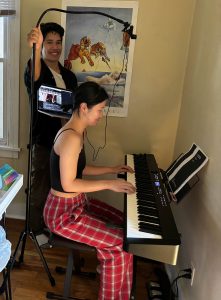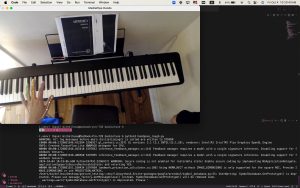General updates:
- Team trip to Home Depot to buy parts to connect the webcam gooseneck to the tripod. The connecting part of the gooseneck was a wider tube (⅝”) and not threaded while the connecting part of the tripod was a smaller threaded screw (¼”) so it was difficult to find a connector for the 2. However, with assistance from the Home Depot staff we landed on using multiple spacers. We screwed the tripod connecting part with the help of a heat gun to create threads in the spacers. In the future, we might have to glue the spacers to the gooseneck tube to make sure it stays in there.
- We met with Dueck’s students and tested our newly built stand. Images are attached below. The stand worked great! It was stable (didn’t require a counterweight) and was tall enough to capture all the keys on the keyboard. Additionally, the gooseneck was able to stretch enough horizontally such that the pianist’s head did not block the view of their hands. The webcam’s USB cable was a bit short so it was inconvenient to hold the laptop close to the camera stand. Additionally, the USB cable kept bumping into the pianist’s head. We have ordered velcro for the purpose of wire management and a USB extension cable.
- We also gather video of scales & Hanon specifically to test with. More details can be found in Shaye’s report


- As per Joshna and Prof Bain’s suggestion we met with Varun to ask for advice on using the KV260. More details can be found in Jessie’s report.
Design Changes:
Based on the feedback we received from Varun, we have decided to drop using the KV260 and commit to pivoting to the RPi with an accelerator to accelerate our hand landmark model.
Updated Schedule:
We are slightly behind our originally planned schedule of finishing the CV and FPGA integration by the coming Wednesday; additionally, our plans have shifted to using the RPi instead of the FPGA. Here is our updated schedule with the RPi:
Due 11/01 –
- Jessie: finish moving the model to RPi and research how to connect the buzzer and display and web app hosting RPi using UART
- Shaye: write many versions of the tension detection algorithm for RPi (see Shaye’s status report)
Due 11/06 – (next meeting with Professor Dueck’s students)
- Shaye: finalize tension detection algorithm using output of RPi model (see Shaye’s status report for more)
Due 11/08 –
- Jessie: finish implementing buzzer feature and set up UART connection with web app hosting RPi
(11/08-11/11) – buffer time
Due 11/11 – start full system integration


